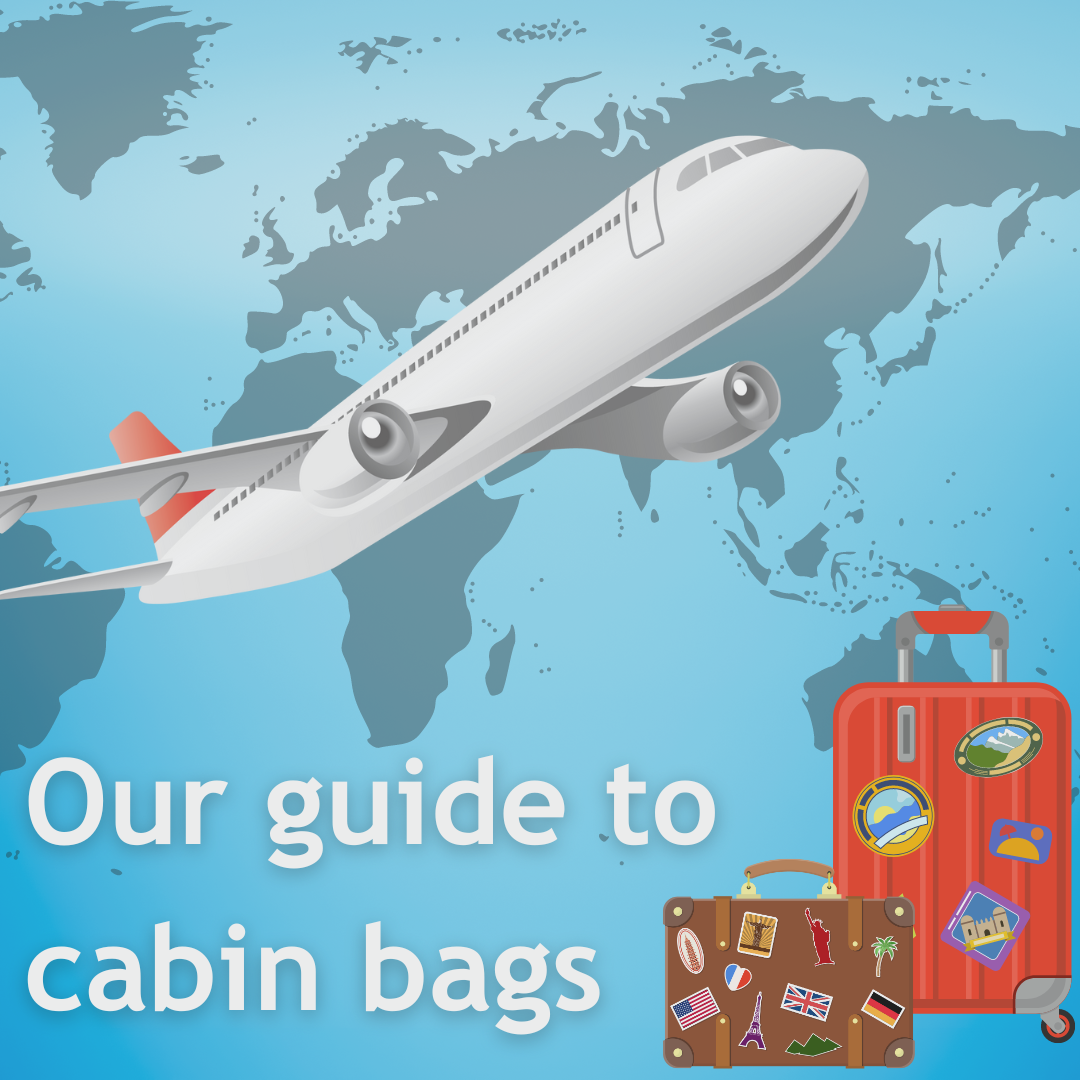Our guide to cabin bags
July 08, 2024
Traveling abroad is an adventure full of new experiences, and sometimes a little bit of stress. One of the most common challenges us holiday goers’ face is navigating the maze of airline regulations, especially when it comes to cabin bags. The rules always seem to change, so whether you’re a seasoned flyer or embarking on your first trip abroad, understanding the do’s and don’ts of cabin luggage can make your journey a little less turbulent.
From size and weight restrictions to packing tips and security screening, this guide will help you to become a master of the art of all things cabin bags. Say goodbye to last-minute surprises at the airport and hello to comfortable, hassle-free travel.

Size and weight restrictions
Understanding the size and weight restrictions for cabin bags is crucial to avoid hidden fees or the need to check your bag at the gate. Unfortunately, there is not a one size and weight fits all when it comes to different airlines, so it’s always best to check your airline’s specific regulations before packing. A few of the common UK airlines cabin bag size and weight restrictions are below:
– Easy jet: Max 15kg – 56 x 45 x 25 cm (Additional cost)
– Ryanair: Max 10kg – 55 x 40 x 20cm (Additional cost)
– British Airways: Up to 23kg – 56 x 45 x 25cm (Included with flight)
If you’re worried your cabin bag may be too heavy, use a luggage scale to ensure your bag meets weight restrictions and also try to make sure your bag isn’t over packed to avoid the risk of it not fitting in the overhead lockers. It can also still be affordable to book a larger bag to be stored in the hull ahead of time if you are traveling for a longer period and concerned about the size of your cabin bag, so you may want to consider this. In addition to your main cabin bag, most airlines also allow free hand luggage such as a handbag or small backpack. These should fit under the seat in front of you and are helpful to bring extra items for your trip. However, in some cases a handbag or backpack can be considered as cabin luggage and therefore you would only be allowed one bag on your flight, so ensure you research your airlines allowances and restrictions.
Types of cabin bags
Choosing the right type of cabin bag can make a big difference in your travel experience when going on holiday. Wheeled suitcases are great for easy manoeuvrability, while backpacks help to offer hands-free carrying. Duffel bags, on the other hand, can be more forgiving with space but might be harder to carry around, so bare this in mind. Make sure that whatever type of cabin bag you decide to go with it meets your airlines size and weight limits.
Packing essentials
Packing your cabin bag and hand luggage efficiently, ensures that you have everything you need within reach during your flight. Make sure to pack your travel documents such as your passport and boarding passes, medications if your outward and return airline allows, a change of clothes for when you get to your destination, and essential toiletries in your cabin bag. It’s also a good idea to keep your electronics such as laptops, headphones and chargers easily accessible, as you might need to take them out during security checks and also want access to them during the flight. As well as this, if you’re a parent travelling with young children you may want to pack toys and snacks to keep them occupied during the flight.
Liquids and gels
There are currently restrictions on the amount of liquids you can take in your hand luggage. Liquids include items such as drinks, cosmetics and toiletries, sprays, gels and contact lens solutions to name a few. Liquids in cabin bags and hand luggage must follow certain guidelines such as not being more than 100ml per item, kept in a transparent resealable plastic bag measuring 20 x 20cm, 1 plastic bag per person and taken out of your bag and shown at airport security.
The Department of Transport were due to change the rules around liquids in cabin bags in June 2024, meaning that there would no longer be a 100ml or less per item rule and this would change to 2litres due to new 3D scanners. Only six UK airports were able to meet this deadline and have the new scanners installed. As most airports including Heathrow and Gatwick did not meet this June 2024 deadline, it has been extended until 2025 and additionally, as a result of long queues and delays during security at the six UK airports that were successful in introducing these 3D scanners, they have now reverted back to the 100ml per item rules for the time being1.
Due to the upcoming changes now not being put in place and not all airports being able to meet the changes, it’s recommended that you check the individual airport that you will be travelling from to ensure you don’t get caught out. Click here, if you would like to read more about the upcoming 100ml rule change. It is also important to note that countries outside the UK might also have different rules on carrying liquids, so you should also check these rules with the relevant airlines and airports before your return journey2.
Security screening tips
Navigating security screening can be a stressful part of air travel, but with a little preparation, you can breeze through it with ease. Here are some tips to help you get through security quickly and efficiently:
– Organise your bag: Keep your bag organised so you can easily remove items for security inspection. Place items you’ll need to take out, such as liquids and electronics, in accessible compartments.
– Liquids: Follow rules around liquids in your hand luggage such as containers being 100ml or less, kept in a plastic resealable bag and taken out of your bag at security.
– Electronics: Remove larger electronics, like laptops and tablets, from your bag and place them in a separate tray to be scanned.
– Be prepared: Have your passport and boarding pass ready to present to the security officer to help the line run smoother.
Prohibited Items
Airlines and airports have strict regulations on what can and cannot be carried in your cabin bag when on a flight. Below are a few examples of common prohibited items to be aware of3.
– Sharp objects: items such as knifes with a sharp or pointed blade and/or blade longer than 6cm and large scissors with blades longer than 6cm are not permitted in hand luggage.
– Tools: Tools such as hammers, drills, and saws are not permitted in cabin bags.
– Chemicals and toxic substances: Items such as bleach, vehicle batteries and fuel systems, poisons or toxic substances (for example rat poison) and materials that could spontaneously combust are not permitted.
– Ammunition: You cannot take any guns or firearms as hand luggage; you may be able to take them as hold luggage if you check with your airline before you travel. Explosives such as fireworks, flares, detonators and dynamite are strictly prohibited in cabin bags and in the hold.
– Sports equipment: Sports equipment such as heavy bats and sticks, walking/hiking poles and martial arts equipment are not permitted in cabin bags.
Always check the specific regulations of your airline and departure airport, as well as the airport and country you will be travelling to as rules can vary. Another area to consider when travelling abroad and being aware of regulations is medication. Certain medications may not be allowed in countries that you’re travelling to so ensure you have researched this before you travel. It is recommended to get a doctor’s note for your medication that you take abroad and also speak to the international airports you will be travelling to and from for further clarification. If you would like to learn more about what is and is not prohibited in cabin bags during flights, check out the government’s information here.
Although it may seem there are countless rules around cabin luggage when flying abroad, with correct preparation and by following this guide and further information on your airline’s website, it will help to ensure that issues regarding your cabin bags and hand luggage do not arise so you can travel with less stress and more confidence. It’s important to understand that the rules regulations around cabin bags are always changing and may change for different airlines and airports, as well as be different when flying from a UK airport and an international airport on your return journey. We hope this guide has helped to inform you more about cabin bags and put your mind at ease before your next trip away. We hope you have a great time and if you’re looking for travel insurance for your holiday, then you can get a quote with Flexicover here.
1https://www.thetimes.com/travel/advice/airport-security-rules-liquids-laptops
2https://www.travelinsuranceexplained.co.uk/news/100ml-limits-scrapped-what-are-the-new-rules/
3https://www.gov.uk/hand-luggage-restrictions


